Extremadura 14-20 April 2015 : Photo-blog part 1
John Muddeman
16/09/2015 11:51:09
A photographic summary of a private 7-day tour to Extremadura during the peak spring period for just about all the wildlife there! This part covers a few of the notable birds and butterflies seen, such as Spanish Imperial Eagle, Great Bustard, Eagle-owl, Provence Hairstreak & Spanish Marbled White.
Posted in: Flora, Butterflies and Moths, Dragonflies and Damselflies, Birds, Endangered Wildlife and Habitats | Extremadura, Madrid | Mainland Spain, Western Spain, Central Spain
Being a quite relaxed private trip, where quality of sightings far outweighed the 'need' for quantity, it also allowed us plenty of time for casual photography. Despite only having a bridge camera, I was still able to take a few decent pictures of some of the enormous wealth of wildlife we came across during the week.
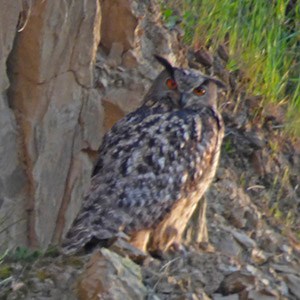 Always impressive, a huge adult Eurasian
Always impressive, a huge adult Eurasian
Eagle-owl glares down from its roost site!
Bubo bubo© John Muddeman
Indeed, far from being the best picture, it was however taken from the vehicle on the road as we passed in low light. Having located this bird a week before, these are still always chance events. The only other time this has happened to me -with a bird so close- was about 10 years ago in Monfragüe National Park.
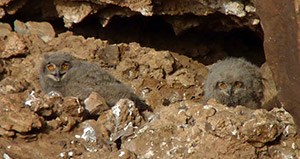 Downy baby Eurasian Eagle-owls
Downy baby Eurasian Eagle-owls
Bubo bubo© John Muddeman
Digiscoped from a far greater distance, the piercing gaze of these two chicks at a different site is still obvious. Three young appear to have fledged from this site, which was fantastic given that the pair at the usual site in Monfragüe National Park failed to appear until rather late in the season and then only for a short period.
 A fine male Great Bustard struts the steppe
A fine male Great Bustard struts the steppe
Otis tarda© John Muddeman
We had two enthralling ancounters with Great Bustards during the week, both with groups of strutting and occasionally displaying males at two sites. This huge male was the clearly oldest, largest and dominant bird among a group of around 20 feisty males, and while the photo is horribly grainy, due to the >200m we kept from the birds, the views with a telescope were of course still superb!
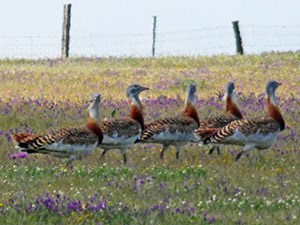 Part of the other group of Great Bustards which we
Part of the other group of Great Bustards which we
watched from the car, having come across them as we
drove across a beautiful pseudosteppe area
Otis tarda© John Muddeman
Part of a different smaller group of superb males, all these birds were true 'plains masters'. Being so close, the effect of heat haze is clear in the picture, but again we had astounding views until the birds left when another vehicle came along and unfortunately flushed them.
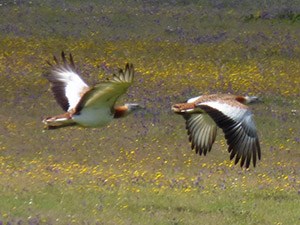 The truly awesome sight of two huge male Great
The truly awesome sight of two huge male Great
Bustards flying over the flower-fillled pseudosteppe!
Otis tarda© John Muddeman
With big males weighing in at around 15kg, these are regularly quoted as being the heaviest flying birds in the world. While it might seem that they would be cumbersome, they are far from it, rising easily into the air after a rapid couple of steps, and then power along using their huge pectoral muscles. In the mid-1980s a small mobile group, presumed to be from the Hungarian population appeared in E England and toured around before disappearing again, while birds from the reintroduced UK population regularly travel to France and back as well. This illustrates just what good fliers and how mobile they can be!
 Two more stunning male Great Bustards!
Two more stunning male Great Bustards!
Otis tarda© John Muddeman
Even the long white whiskers can just be made out on a few of these shots, as well as the more obvious bold barring and overall colour patterns.
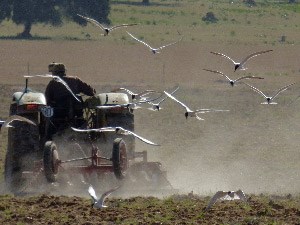 A flock of Gull-billed Terns
A flock of Gull-billed Terns
Gelochelidon niloticum© John Muddeman
A huge stroke of good luck one morning was to spot this farmer working a roadside field. In Extremadura things are often different, with White Storks and Western Cattle Egrets regularly following the plough to search for titbits, rather than gulls! But on this occasion it was a healthy flock of stunning Gull-billed Terns!
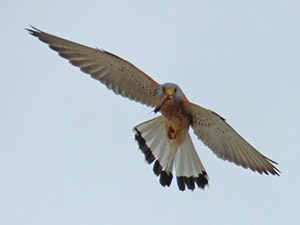 A male Lesser Kestrel carrying food
A male Lesser Kestrel carrying food
Falco naumanni© John Muddeman
Taken by the new observation and photography tower in Trujillo, this adult male Lesser Kestrel shows the poorly spotted white underwing, plain grey hood without moustache, spotted salmony coloured underbody and rather pointed central tail tip typical of the species. The prey, though barely visible here, was a large Mole Cricket, a favoured food of the species.
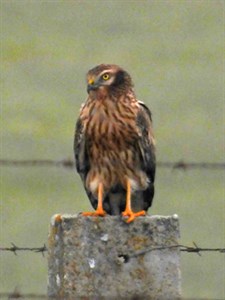 A female Montagu's Harrier rests
A female Montagu's Harrier rests
on a fence post
Circus pygargus© John Muddeman 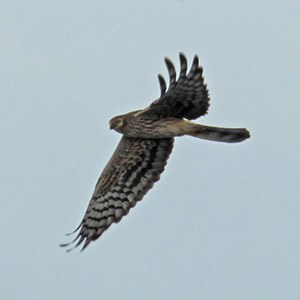 Some of the underwing detail of a female
Some of the underwing detail of a female
Montagu's Harrier in flight
Circus pygargus© John Muddeman
....Another classic bird of the open grassy man-made steppes of Extremadura is the elegant Montagu's Harrier. Sadly its numbers, as for a number of other species occupying the same habitat (and especially Little Bustard) have plummeted here in recent years, and incredibly, in contrast to its relative abundance here just 15 years ago, just a couple of colonies remain in the province of Cáceres! 2015 has been an even bleaker year than normal for the species in the region, since the usual volunteer campaign to save chicks and nest during the (relatively early) harvest remained unorganised for the first time in a decade :-(
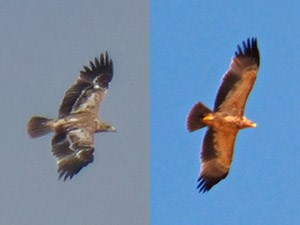 A juvenile Spanish Imperial Eagle circles the steppe
A juvenile Spanish Imperial Eagle circles the steppe
Aquila adalberti© John Muddeman
In contrast to the adults, which are far more sedentary, young Spanish Imperial Eagles disperse widely, occasionally being found out over open steppe such as this bird, which took off on seeing us, but then returned and circled high overhead when persistently harried by a Common Raven!
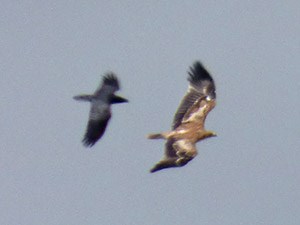 Common Raven chasing a young Spanish Imperial
Common Raven chasing a young Spanish Imperial
Eagle from its territory
Aquila adalberti© John Muddeman
The ensuing dogfight was quite intense at times!
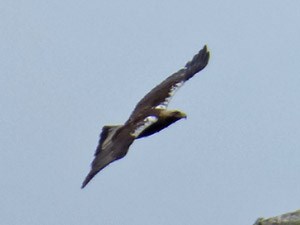 A fine adult Spanish Imperial Eagle
A fine adult Spanish Imperial Eagle
Aquila adalberti© John Muddeman
Adults, such as this well-known bird in Monfragüe National Park, are far more attractively coloured birds. This bird and its mate regularly give remarkable views as they nest just 250m from the road and viewpoint most years!
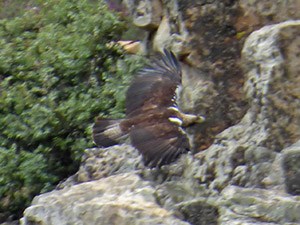 The same fantastic adult Spanish Imperial Eagle
The same fantastic adult Spanish Imperial Eagle
Aquila adalberti© John Muddeman
Just occasionally the birds will drop down below the skyline and that's when the full beauty of their plumage detail can be enjoyed!
 A gorgeous Red-rumped Swallow
A gorgeous Red-rumped Swallow
Cecropis daurica© John Muddeman
Red-rumped Swallows, such as this bird carrying mud to build a nest, are relatively abundant in Monfragüe too, occasionally perching just where you'd like them to!
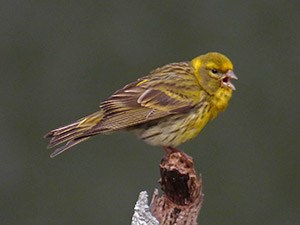 A bright male European Serin
A bright male European Serin
Serinus serinus© John Muddeman
Almost on the same perch as the swallow, this lemoney yellow male Serin sang its heart out, even though it sounds not far off an un-oiled bicycle chain going round!
 Provence Hairstreak
Provence Hairstreak
Tomares ballus© John Muddeman
Not all the winged delights were avian and indeed far from it! This diminutive Provence Hairstreak was a great start to the tour, and though we were in first class dehesa habitat, so well represented in N Extremadura, this was actually taken in Madrid, which also boasts a wonderful variety of habitats and species. This is one of the earliest small butterflies on the wing, and in early and dry years, such as 2015, quite difficult to find even by mid-April.
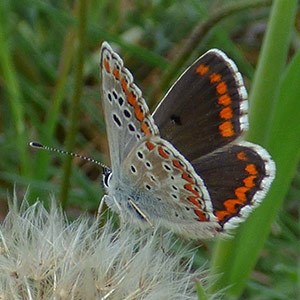 A colourful, fresh Spanish Brown Argus
A colourful, fresh Spanish Brown Argus
Aricia agestis© John Muddeman
Usually now treated as a different species to the very similar Brown Argus of much of the rest of Europe, Spanish Brown Argus is another member of the Lycaenidae family, encompassing the hairstreaks, coppers and myriad of confusing blues... The taxonomy of 'blues' in particular is a rather vexing question which I won't go into here!
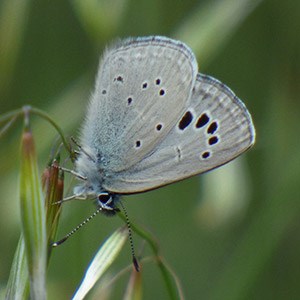 The well-named Black-eyed Blue!
The well-named Black-eyed Blue!
Glaucopsyche melanops© John Muddeman
Another relatively early-flying species, the lovely Black-eyed Blue was quite common in C Spain this spring. This was one of several present at a viewpoint over a river, giving us plenty of time to watch and enjoy them.
 A mating pair of Black-eyed Blues
A mating pair of Black-eyed Blues
Glaucopsyche melanops© John Muddeman
The bright upperside of the male with its neat black border was readily observed in the excellent light, and especially when another male came in to inspect, presumably attracted by the pheromones of the female.
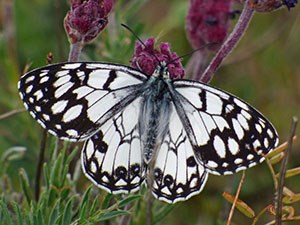 A crisp Spanish Marbled White
A crisp Spanish Marbled White
Melanargia ines© John Muddeman
Another of my favourite early(ish) spring butterflies is the Spanish Marbled White. But with five species to choose from in Spain, marbled whites represent something of an identification challenge if not seen and/or photographed well. The cooler but still mild conditions on this day were perfect for finally bringing one down to rest nearby for us on a grassy roadside verge.
Read more blog posts